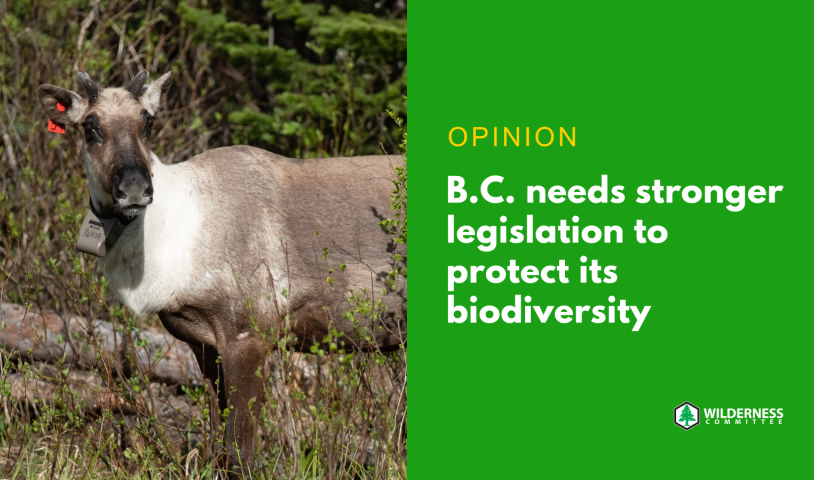OPINION: B.C. needs stronger legislation to protect its biodiversity
Monday, January 29, 2024
As B.C. burns and floods in an endless cycle, it’s become clear that we need systemic change in how the land is treated. A new law, co-developed with First Nations, is required – one that prioritizes biodiversity, at-risk wildlife and ecosystems above industrial extraction.
This could be on the horizon.
In November, the B.C. NDP government released a draft biodiversity and ecosystem health framework, a supposed legislative roadmap prioritizing biodiversity across all sectors. This could be another public relations exercise from a government that’s made several unfulfilled promises on the environment, or it could be a game-changer for decision-making around industrial projects, holding them to a higher standard when it comes to protecting species at risk. We can’t afford to get this wrong.
The B.C. government is accepting feedback on its draft framework until Jan. 31, and the final framework will be released this spring. Yet an explicit commitment and timeline for a new law that has the authority to deny industrial projects incompatible with biodiversity protection is still missing. It’s not clear whether a law will be introduced before the next provincial election, or at all.
As it stands, B.C. has no standalone legal instrument for assessing the effects of industrial projects on biodiversity, including at-risk species, despite the NDP promising in 2017 that it would introduce one. In subsequent years, and in working group consultations with the government, representatives from logging, mining and other resource industries have advocated for the province to focus on “ecosystem-based” and “adaptive” management in forming its biodiversity policies.
If a new [biodiversity law] comes into effect, a strong biodiversity law should be proactive, enforceable, precise, loophole-free and Indigenous-led.
These vague approaches to wording have made appearances in the latest biodiversity draft framework. If this language is used to shape any future laws on biodiversity, it may leave the door open to the dilution of the law’s intention. In practice, without careful implementation structured into law, these management strategies have indeed favoured extractive industries and fallen short of building more resilient ecosystems in various parts of the world. If this language persists in B.C.’s own approach, without a legal framework firmly enforcing biodiversity goals, the province is likely to continue greenlighting industrial projects that impact biodiversity by excluding protection thresholds and permanent boundaries for areas that are off-limits to destruction. In allowing industrial projects to hide behind vague terms like “adaptive management,” biodiversity protection in B.C. would continue to be at risk.
If a new one comes into effect, a strong biodiversity law should be proactive, enforceable, precise, loophole-free and Indigenous-led. A weak law would be vague, reactive and continue to provide loopholes while pitting species protection against corporate interests.
There are clear guidelines that should be adopted to ensure B.C.’s new law genuinely protects life-sustaining biodiversity.
A law that fundamentally tips the balance of power to protecting life-giving biodiversity is needed to confront this crisis.
First, it must provide enforceable protections for species and ecosystems at risk. Biodiversity includes the variety of species and the number of individuals within each. Any attempt to protect biodiversity must legally protect declining species in order to rebuild populations and maintain genetics.
Canada and its provinces must return land-management decisions to Indigenous titleholders. B.C.’s new biodiversity law must be developed with and have consent from First Nations communities to ensure Indigenous titles, rights, laws, knowledge, worldviews and needs for self-determination are all built into the law from the beginning.
A biodiversity law is only as strong as its weakest link. The law must guide projects that are compatible with biodiversity targets and deny ones that are not. Project review processes should be thorough, rigid and exemption-free, inherently incentivizing proposals that fit within biodiversity objectives.
An effective law must incorporate equity for communities and workers. Places like Costa Rica have laws that protect biodiversity while maximizing the benefits communities receive from nearby resource extraction. Ending the transfer of wealth out of communities is key to ensuring ecosystems are cared for while ensuring community resiliency.
Finally, a biodiversity law in B.C. must reward good behaviour rather than punish bad. One of the biggest barriers of the federal Species at Risk Act is that it positions at-risk species as liabilities rather than as precious and valuable assets; a strong law would flip this thinking.
B.C. must show it is serious about biodiversity by providing the target date for new legislation and implementing strong interim measures for species acutely at-risk in the meantime, such as the northern spotted owl or the southern mountain caribou.
Once a new legal foundation is in place to prioritize biodiversity, industries will adapt to fit within it. A law that fundamentally tips the balance of power to protecting life-giving biodiversity is needed to confront this crisis. This is what the B.C. NDP government is responsible for delivering, and citizens must accept nothing less.





